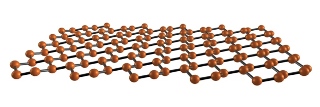Feb 4 2015
Researchers at The University of Texas at Austin's Cockrell School of Engineering have created the first transistors made of silicene, the world’s thinnest silicon material. Their research holds the promise of building dramatically faster, smaller and more efficient computer chips.
 Buckled honeycomb lattice structure of silicene.
Buckled honeycomb lattice structure of silicene.
Made of a one-atom-thick layer of silicon atoms, silicene has outstanding electrical properties but has until now proved difficult to produce and work with.
Deji Akinwande, an assistant professor in the Cockrell School’s Department of Electrical and Computer Engineering, and his team, including lead researcher Li Tao, solved one of the major challenges surrounding silicene by demonstrating that it can be made into transistors —semiconductor devices used to amplify and switch electronic signals and electrical power.
The first-of-their-kind devices developed by Akinwande and his teamrely on the thinnest of any semiconductor material, a long-standing dream of the chip industry, and could pave the way for future generations of faster, energy-efficient computer chips. Their work was published this week in the journal Nature Nanotechnology.
Until a few years ago, human-made silicene was a purely theoretical material. Looking at carbon-based graphene, another atom-thick material with promise for chip development, researchers speculated that silicon atoms could be structured in a broadly similar way.
Akinwande, who also works on graphene transistors, sees value in silicene's relationship to silicon, which chipmakers already know how to work with.
“Apart from introducing a new player in the playground of 2-D materials, silicene, with its close chemical affinity to silicon, suggests an opportunity in the road map of the semiconductor industry,” Akinwande said. “The major breakthrough here is the efficient low-temperature manufacturing and fabrication of silicene devices for the first time.”
Despite its promise for commercial adaptation, silicene has proved extremely difficult to create and work with because of its complexity and instability when exposed to air.
To work around these issues, Akinwande teamed with Alessandro Molle at the Institute for Microelectronics and Microsystems in Agrate Brianza, Italy, to develop a new method for fabricating the silicene that reduces its exposure to air. To start, the researchers let a hot vapor of silicon atoms condense onto a crystalline block of silver in a vacuum chamber. They then formed a silicene sheet on a thin layer of silver and added a nanometer-thick layer of alumina on top. Because of these protective layers, the team could safely peel it of its base and transfer it silver-side-up to an oxidized-silicon substrate. They were then able to gently scrape some of the silver to leave behind two islands of metal as electrodes, with a strip of silicene between them.
In the near-term, Akinwande will continue to investigate new structures and methods for creating silicene, which may lead to low-energy, high-speed digital computer chips.
The U.S. Army Research Laboratory's Army Research Office, the Cockrell School's Southwest Academy of Nanoelectronics and the European Commission's Future and Emerging Technologies Programme funded Akinwande’s research.